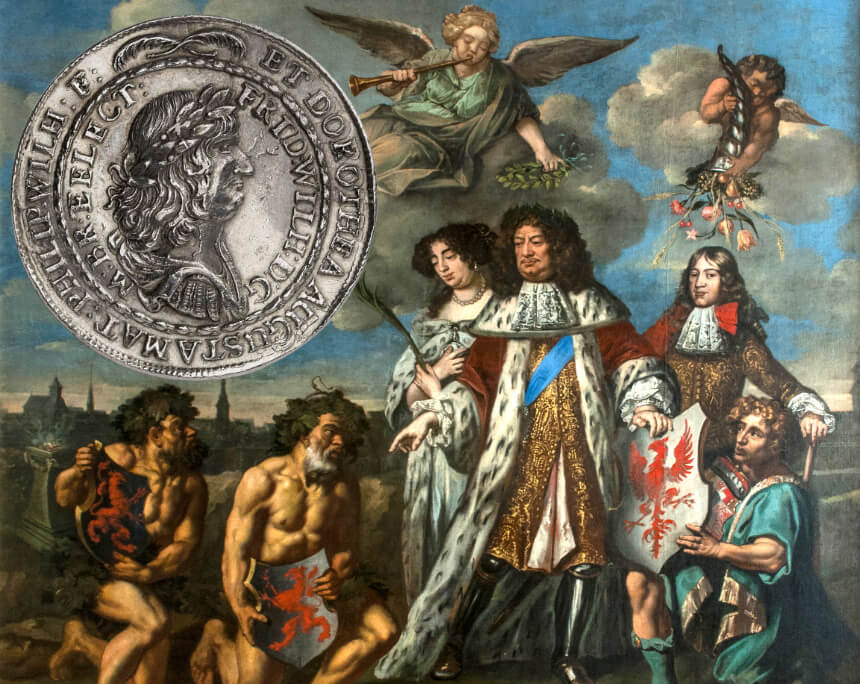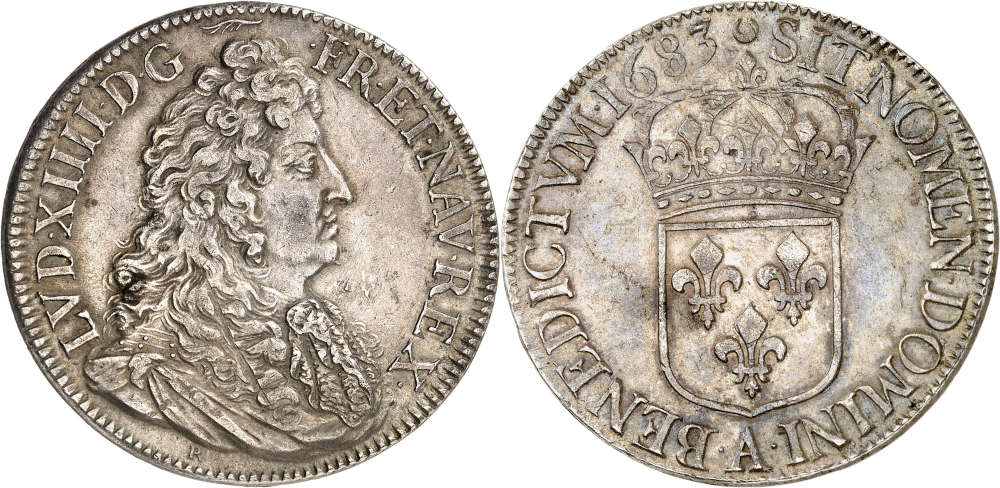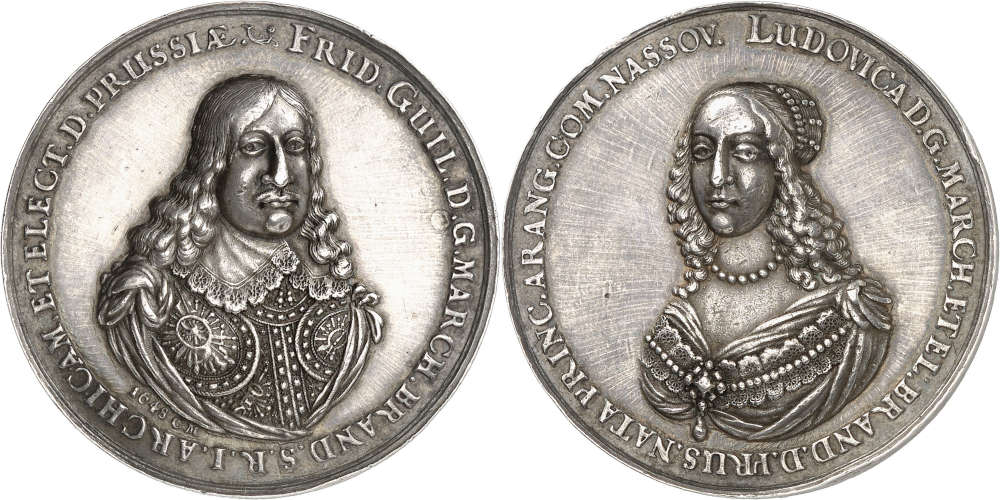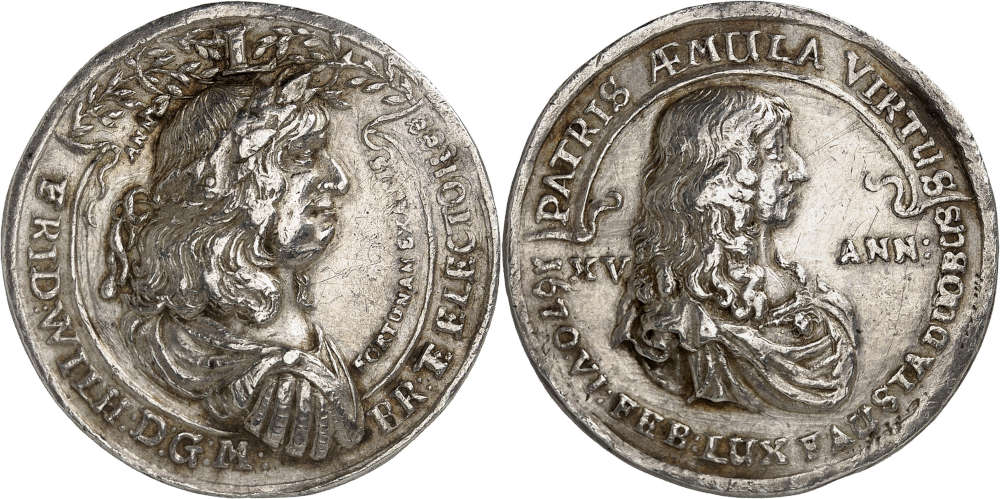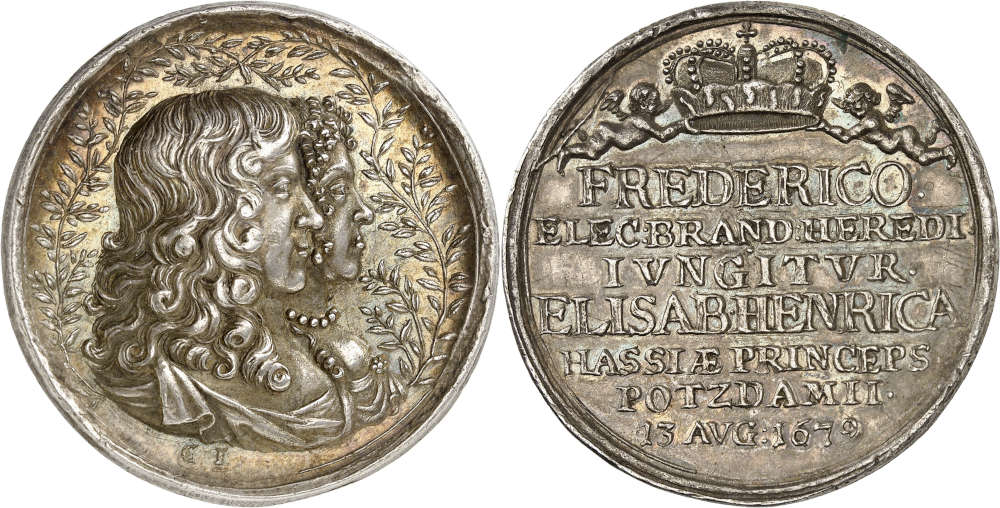The Great Elector, Taxes and the Rise of Prussia
by Ursula Kampmann
Content
When Frederick William came to rule the Margraviate of Brandenburg, the realm he inherited was in a deplorable state: during the Thirty Years’ War, half the population had died – from starvation, disease and the cruelty of Swedish soldiers. Depending on the region, 15 to 85% of the farms lay fallow and the formerly proud cities had lost up to two thirds of their inhabitants.
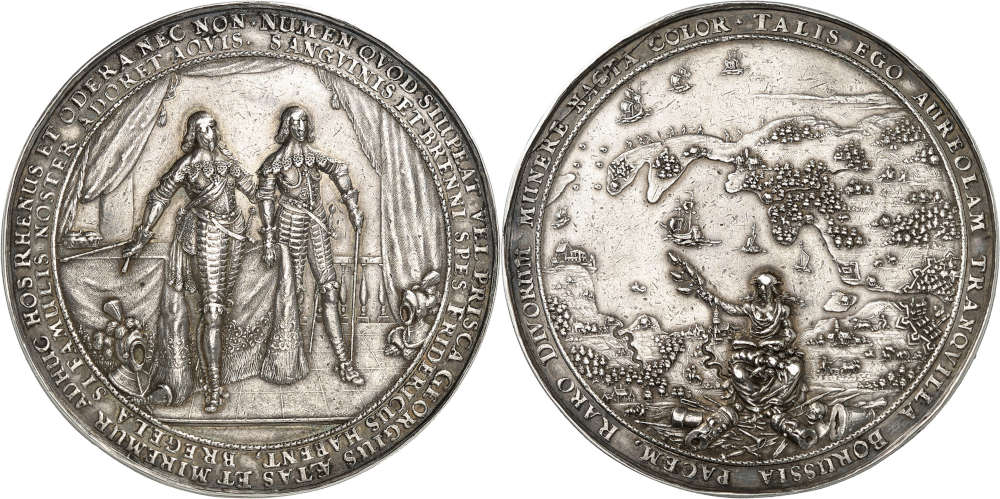
1639 medal by Sebastian Dadler. Rare. Very fine. Estimate: 1,500 euros. From Künker auction 401 (5/6 February 2024), No. 1641.
A Land in Ruins
Of course, Frederick William’s subjects longed for peace. And they yearned for a ruler who would effectively protect them against any threat from the outside. After all, this was where George William, the father of Frederick William, had utterly failed. Since 1639, the latter had lived safely with his crown prince in the Prussian city of Königsberg and thus far away from Brandenburg. The citizens of Königsberg commissioned Sebastian Dadler to create a medal in 1639 to express their hopes. The reverse depicted the personification of peace (Pax) in front of a map of the Duchy of Prussia. The translation of the inscription reads: This is how I, peaceful Borussia, am worshipped, for I have been given golden peace as an exquisite gift from heaven. However, there was still no talk of peace when George William died in 1640 and Frederick William took over the rule at the age of 20.
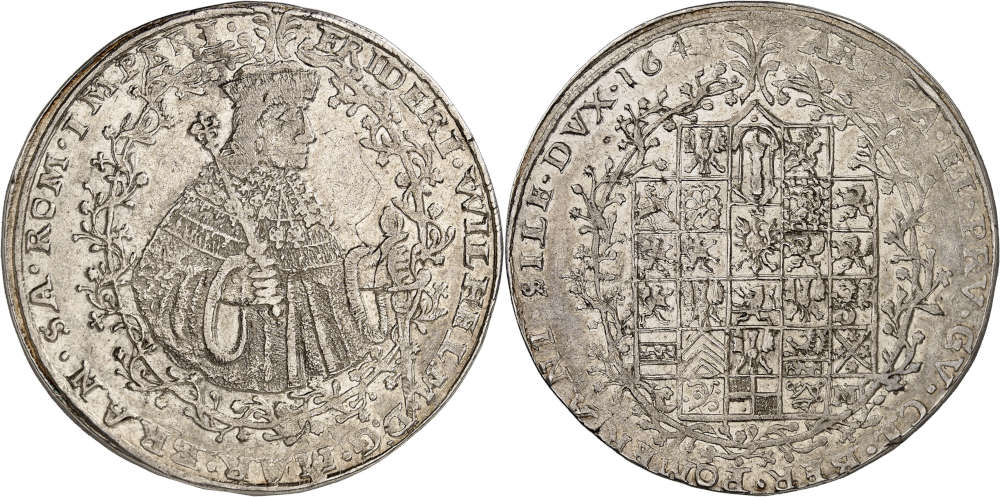
1641 taler, Berlin. Rare. Very fine to extremely fine. Estimate: 1,500 euros. From Künker auction 400 (1 February 2024), No. 76.
Soldiers, Taxes and How This Related to Administration
The main reason for Brandenburg’s terrible fate was the fact that it had no standing army of its own. Thus, it could not effectively oppose anyone who used its territory as a base for their troops and fed their soldiers “off the land”. Local militias were out of their depth. Frederick William decided to raise a standing army instead. But this was expensive, and his tax system anything but sound.
After all, income taxes in today’s sense of the word did not exist in the early modern period. Instead, rulers derived their revenue from the yield of their estates and the income from state privileges. One of these privileges was the right to mint coins. Every ruler received a share of the seigniorage, i.e., the amount left after deducting material and production costs from a coin’s face value. However, all electoral sources of income combined added to merely ten million talers a year. And these resources had to be sufficient to fund not only the court but also the administration of the entire state. Such a meagre annual budget simply was not enough to afford a powerful standing army.
The traditional solution was to negotiate with the members of the Diets of the various parts of his realm in times of war. They were obliged to co-finance the realm’s defense. However, it was not specified to what extent, so the issue was hotly debated in times of need. And this process took time. By the time they had finally made up their minds, collected the taxes and raised an army, the enemy had long invaded the territory.

Great Britain. Gaming tokens with the portrait of Charles I, n.d. (1625-1628). Very fine. Estimate: 50 euros. From Künker auction 401 (5/6 February 2024), No. 1100.
Instead, Frederick William forced his citizens to pay annual taxes to fund the military. Of course, his subjects were not happy about this. Once again, there were heated debates. The city of Kleve even threatened Frederick William to suffer the same fate as Charles I of England (fig. 4), who had been executed by his Parliament – the English equivalent to the German Diet.
But Frederick William held his ground. And, eventually, they reached an agreement. However, in order to collect the new military taxes and administer the budged, his realm was in need of a completely new authority. Following the French model, Frederick William installed a General War Commissariat in the April of 1655. What had been devised as a temporary body developed into an essential pillar of Brandenburg-Prussia’s fiscal administration.
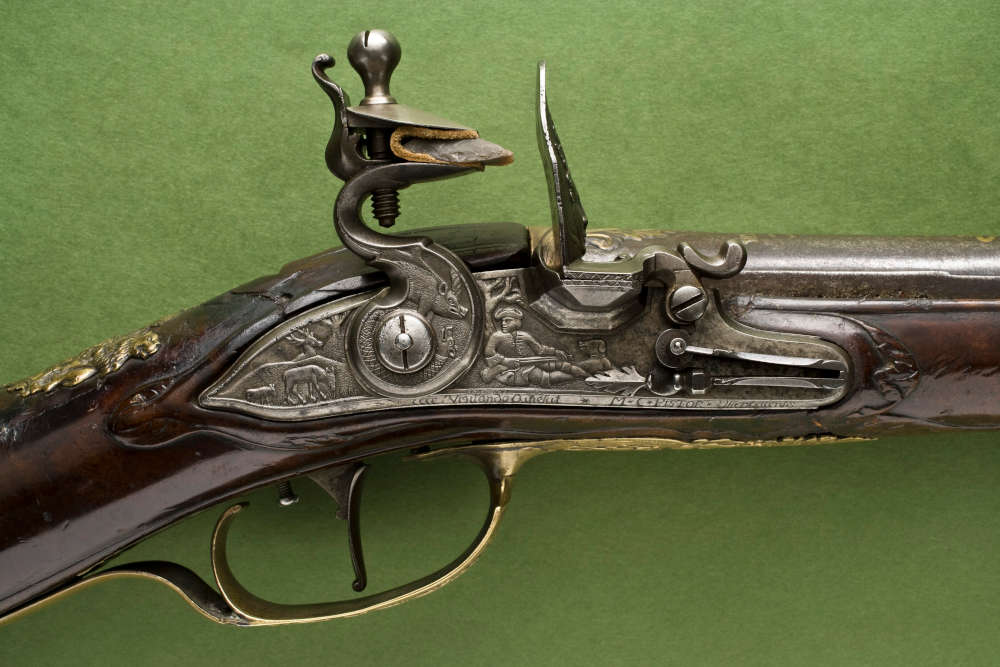
Detail of a flintlock musket. The then ultra-modern mechanism abolished the need to use a fuse to ignite the gunpowder. Of course, the muskets of soldiers were not as splendidly worked as this musket from the armory of the Royal Palace in Stockholm.
What You Can Do If You Do Not Collect Enough Tax
Frederick William’s army grew quickly. While he had 3,000 soldiers at his disposal in 1641/2, there were as many as 8,000 between 1643 and 1646, 25,000 during the First Northern War and as many as 38,000 in the Franco-Dutch War. The Franco-Dutch War was fought between the Netherlands and France, so it is reasonable to wonder why Frederick William needed so many soldiers for a war that did not concern him.
Once again this was about finances. Even high taxes were not enough to fund a standing army of the scale that Frederick William had in mind. As a young adult, Frederick William had spent many years in the Netherlands and wanted to have the modern equipment he had seen there. No more pikes! No more matchlock firearms! He wanted flintlocks. These weapons used a flint to ignite the gunpowder, which drastically increased the rate of fire and their reliability.
Speaking of artillery – these were the weapons of the future! Frederick William switched to standardized guns instead of carrying separate ammunition for every cannon.
The elector founded a school for cadets to standardize the training of officers. But he also made sure that soldiers were paid regularly and cared for when they retired or became disabled. The soldiers were content under his rule, as evidenced by the low number of desertions.
All this was expensive. So, it was rather fortunate that war was waged all over Europe at the time, and that the many rulers were quite happy to pay large sums of money to have a well-functioning army on their side. These payments were called “subsidies” and were made so that an army intervened or – sometimes – stayed home. Providing soldiers in exchange for subsidies became a wonderful business model. Frederick William perfected the trade in soldiers and became a master of opportunistic and unprincipled politics. His diplomats downright auctioned off his army to whoever paid most. Supporting the France of Louis XIV on one day and the Habsburg Emperor Leopold I on the other, he changed sides so quickly that even his contemporaries were dizzy with confusion.
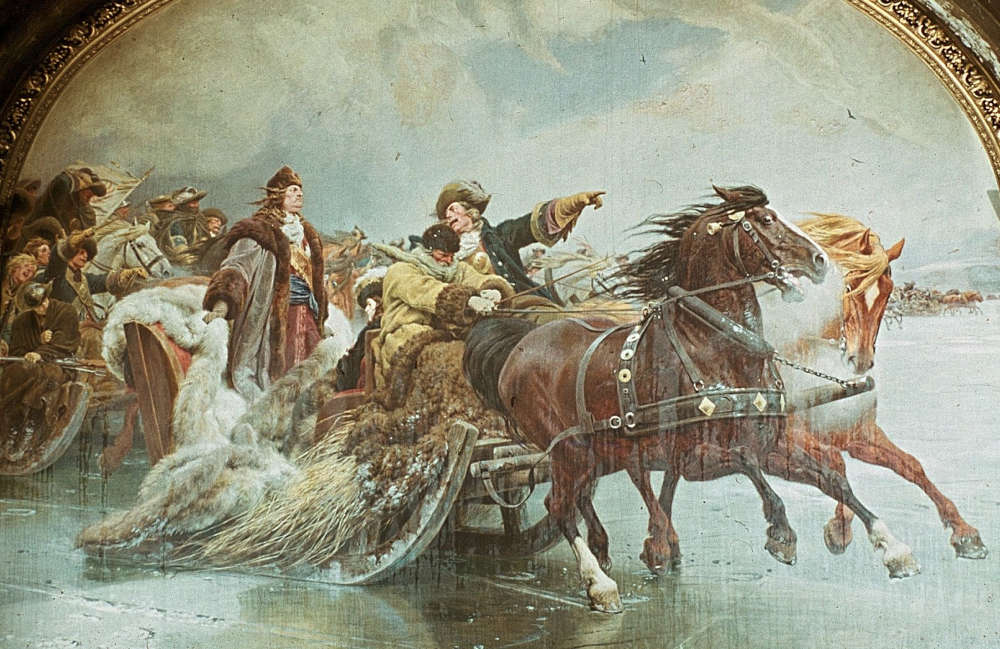
Crossing of the Curonian Lagoon in 1679 at the head of the Brandenburg army during the winter campaign of 1678/9. Mural for the Berlin Hall of Fame (Ruhmeshalle) by Wilhelm Simmler around 1891. Destroyed by a bomb hit.
The Limits of a Middle Power
Sometimes Frederick William did not demand money for his services but political concessions. After all, the elector knew that it was not military success that would enable him to expand his territory, but the favor of the great powers of his time.
Thus, Frederick William achieved his greatest success long before he raised his army. During the negotiations for the Peace of Westphalia, he was supported by France in gaining the eastern part of Pomerania along with the former bishoprics of Halberstadt, Minden and Magdeburg, as France hoped to create a counter-force to the Habsburgs.
Another example was how he removed Prussia from the grip of Polish feudal lordship. This could only be achieved because two circumstances coincided at the time: Poland wanted to secure Brandenburg’s support against Russia and was willing to give up its feudal power over Prussia. And, at the same time, Leopold I needed the vote of Elector Frederick William to become emperor. He got the vote – in return for agreeing to this deal.
The famous Battle of Fehrbellin, on the other hand, did not really expand his territory. This was because France and the emperor insisted that Frederick William returned all conquered territories to the Swedes – both powers preferred a weak Sweden to a strong Brandenburg.
The Protection of the Realm
The actual reason for Brandenburg or rather Prussia’s rise to power was nothing but luck: the competent ruler Frederick William reigned for 48 years and thus longer than any other member of his family. And he left such a large number of children that the continuity of his dynasty was assured for generations to come.
His two wives bore him seven sons. This made it virtually impossible for the male line of the House of Hohenzollern to die out. And Frederick William emphasized this time and again on his medals. Particularly impressive is a 1678 medal created during the winter campaign against the Swedes. The elector was already 58 years old at the time, an age at which death was an imminent threat to many others.

1678 silver medal. Obv. Berlin city view. Rv. Dorothea and her children. Extremely rare. Extremely fine. Estimate: 5,000 euros. From Künker auction 400 (1 February 2024, No. 81.
The extremely rare medal shows on one side a view of the city of Berlin, which Frederick William had begun to rebuild and fortify. Above we can read LUCIDA AQUILAE, the aquila constellation. It is one of the 21 constellations of the north that have been known since ancient times, and also referred to the heraldic animal of the House of Hohenzollern. Thus, we can interpret the depiction as follows: Berlin and the Hohenzollern played the same role in Northern Europe as the aquila constellation – an eternal constant.
This claim is emphasized by the message on the other side. Its legend reads MUNIMENTA IMPERII (= the protection of the realm) and depicts the elector’s second wife surrounded by her children. To her right is her oldest son, Philip William. To her left are his two smaller brothers, Albert Frederick and Charles Philip. The eldest sister Maria Amalia offers fruit or sweets on a plate, and one-year-old Christian Louis reaches for it. He sits on his mother’s lap, as does four-year-old Elizabeth Sophie. Dorothea’s seventh child is not depicted as it had passed away two years earlier.
Another, much more common variety of this medal depicts a different reverse: an eagle’s nest with six eaglets. Every eaglet represents one of the princes that were still alive when the medal was minted.
Wilhelm Henry, his oldest son, and Charles Emil, the second-born – who can be seen in fig. 12 on the occasion of this 15th birthday together with his father – had already passed away by then. Frederick (fig. 13) became crown prince in 1674.
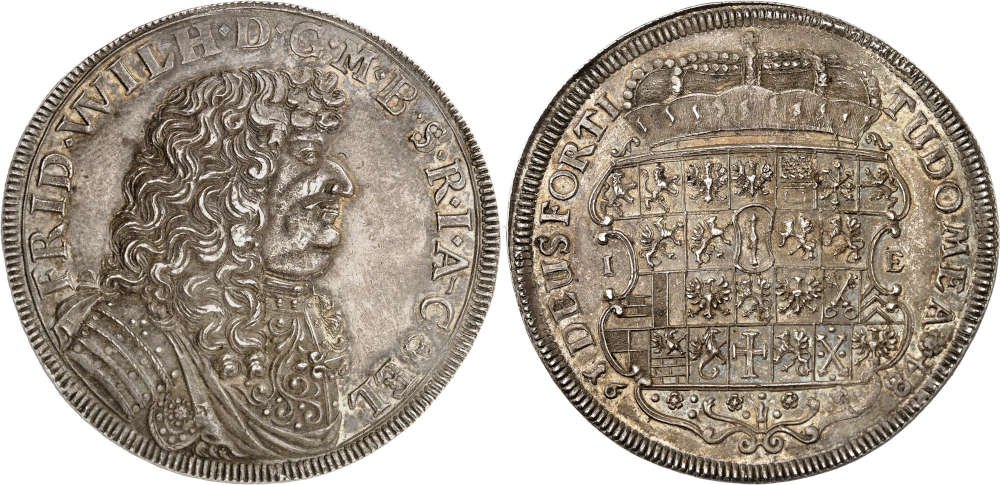
1684 reichstaler, Magdeburg. Very rare. About FDC. Estimate: 40,000 euros. From Künker auction 400 (2024), No. 82.
The Myth of the Great Elector
Frederick William died in 1688. He had already been referred to as the Great Elector during his lifetime. And, actually, this was not very remarkable. Many eulogists honored their patrons with the epithet “great”. What is remarkable is that he is often still called the “Great Elector” in Germany today, praising his ceaseless efforts to advance Prussia. His maniacal work ethic, his obsession with detail and his tireless efforts to multiply the power of the Hohenzollern turned Frederick William into a role model that his successors identified with. It was they who turned the Great Elector into the immortal myth he is today.







